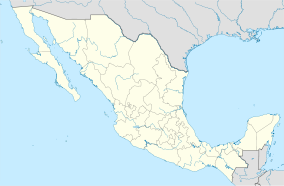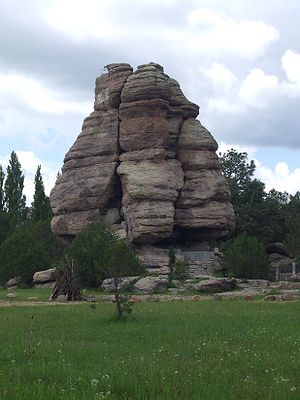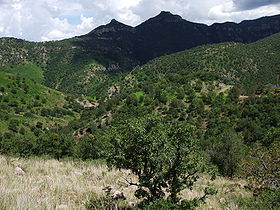- Cumbres de Majalca National Park
-
Cumbres de Majalca National Park IUCN Category II (National Park)Location Chihuahua, Mexico Nearest city Chihuahua, Chihuahua Coordinates 28°48′15″N 106°29′6″W / 28.80417°N 106.485°WCoordinates: 28°48′15″N 106°29′6″W / 28.80417°N 106.485°W Area 4,772 hectares (11,790 acres) Established September, 1 1939 [1] Governing body Secretariat of the Environment and Natural Resources The Cumbres de Majalca National Park is located 88 km northwest of the city of Chihuahua in the state of Chihuahua, Mexico. The park showcases extraordinary rock formations that have been shaped by wind and water erosion. The park was created by presidential decree in 1939 encompassing 4,772 hectares to protect the endemic flora and fauna. The park is characterized by pine and oak forest. The park is one of the few areas in Mexico that are inhabited by black bear.
The park is frequented by residents of the state capital city. The area is popular with rock climbers, hikers, and campers; there are 53 km of roads for hiking and mountain biking. Camping including backcountry camping is permitted and there are rental cabins available. Access to the park is by federal highway number 45 that goes from Chihuahua to Ciudad Juárez.
Contents
History
The Cumbres de Majalca National Park was created by the federal government on September 1, 1939. The protected zone encompassed an area of 4,772 hectares (11,790 acres). The park was created to help preserve natural habitat for many species of animals and plants. After the creation of the national park during the mid 20th century, the park underwent a reforestation of different coniferous species.[2]
Geography
Cumbres de Majalca National Park is located in the central part of the state of Chihuahua near the city of Chihuahua. The park is found in the Sierra de Majalca mountain range a subdivision of the Sierra Madre Occidental. Mountain peaks in the park reach an elevation of 2,600 meters above sea level. The park is part of the dominant Transition Bavícora-Bustillos Transition which is characterized by many small elevated valleys surrounded by volcanic mountains. The mountains in the park are not of notable rank in the state, but the highest peaks in the park are: Cerro Las Escobas, Cerro La Puerta, Cerro Los Almíceres, and Cerro del Agua. The park is almost completely covered by volcanic rocks that have been shaped into amazing formations by wind and water erosion.
Sierra de Majalca is the point of origin of the Sacramento River that flows towards the state capital city. The Sacramento River empties into the Chuvíscar River before reaching Chihuahua, Chihuahua.
Climate
According to the Köppen climate classification, the park has two different climates. A (BSk) semiarid climate occurs in the lower elevations in the park where temperatures can reach 35°C (95°F) in the summer and temperatures fluctuate largely in the winter from cool to hot. The steppe zones in the park have a rainy season at the end of the summer and few winter snowfalls. A (Cwa) humid subtropical with hot summers and cold winters occur in the higher elevations where temperatures can fall to -10°C (14°F) in the winter and averages 112 days under 0°C (32°F). During the winter in the higher elevations, snowstorms come frequently increasing in the at the end of the season.
Climate data for Majalca Month Jan Feb Mar Apr May Jun Jul Aug Sep Oct Nov Dec Year Average high °C (°F) 10
(50)12
(54)16
(61)21
(70)26
(79)28
(82)27
(81)26
(79)25
(77)19
(66)14
(57)10
(50)19.5 Average low °C (°F) −8
(18)−6
(21)−5
(23)−2
(28)1
(34)8
(46)12
(54)11
(52)10
(50)4
(39)−2
(28)−7
(19)1.4 Precipitation cm (inches) 2.4
(0.94)1.2
(0.47)0.6
(0.24)0.8
(0.31)2.4
(0.94)4.4
(1.73)11.0
(4.33)13.0
(5.12)11.5
(4.53)4.5
(1.77)1.2
(0.47)2.0
(0.79)55.0
(21.65)Source: Weatherbase Flora and fauna
Pine forests are found from the high elevations to the transition zone between the mountains and the steppe. The main species of conifers found in the park are: Pinus leiophylla, Pinus cembroides, Pinus engelmannii , and several species of Abies. The lower elevations have a steppe vegetation with a variety of grasses and small bushes. Several species of Juniperus dot the steppe and the transition zone.
The park is part of a fragile ecosystem which includes a few endangered species like: Ursus americanus and Felis concolor. Other mammals that can be found in the park are: Odocoileus virginianus, Sylvilagus floridanus, Erethizon dorsatum, Lynx rufus, and Canis latrans. There are few reptile species that inhabit the lower elevations mostly small lizards. One known reptilian species is the Northern Mexican Pine Snake, Pituophis deppei jani. The most common avian species observed in the park are: Falco peregrinus, Aquila chrysaetos, Meleagris gallopavo, Phasianus colchicus, Picoides arizonae, Picoides stricklandi, and Picoides scalaris.
See also
References
- ^ "Conanp-Sig". Conanp.gob.mx. http://www.conanp.gob.mx/sig/?id=tw_redireccion. Retrieved 2010-07-26.
- ^ "Decreto Cumbres de Majalca". Cemda.org.mx. http://www.cemda.org.mx/infoarnap/instrumentos/decretos/cumbresmajalca.htm. Retrieved 2010-07-26.
External links
Categories:- IUCN Category II
- Geography of Chihuahua
- Sierra Madre Occidental
- National parks of Mexico
- Protected areas established in 1939
Wikimedia Foundation. 2010.







